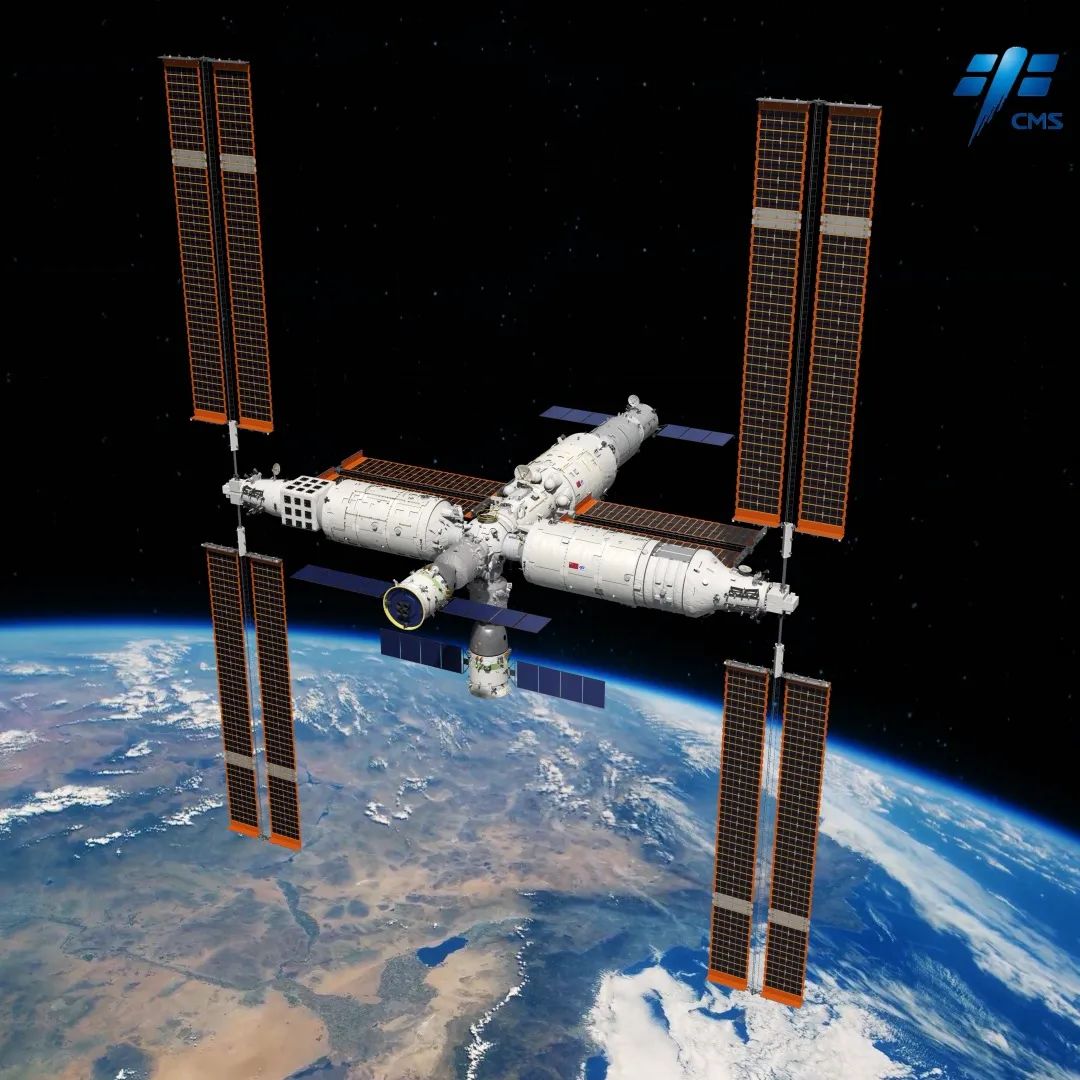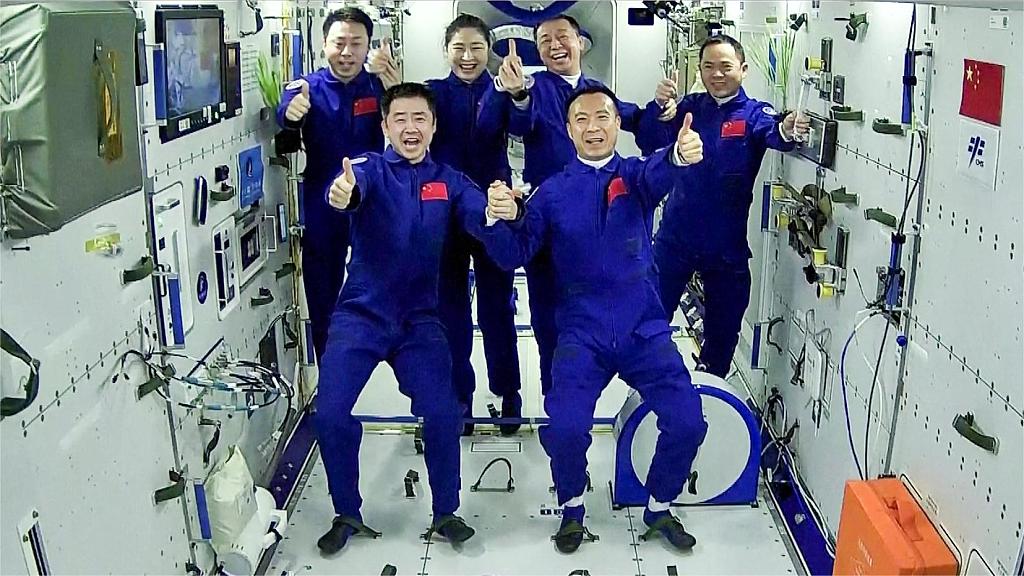
The T-shaped structure of China's space station. /via China Manned Space Agency
The T-shaped structure of China's space station. /via China Manned Space Agency
China is set to launch a new spacecraft, Shenzhou-17, to its space station in October from the Jiuquan Satellite Launch Center in northwest China.
The spacecraft will dock with the forward port of the Tianhe core module of the China Space Station (CSS), forming a combination of three modules and three spaceships.
The CSS currently consists of three modules – the core module Tianhe and two lab modules, Wentian and Mengtian.
20 years on China's manned space mission
This year marks the 20th anniversary after the launch of Shenzhou-5 spacecraft, China's first manned space mission that sent astronaut Yang Liwei into space on October 15, 2003, solidifying China's position as the third country, following the former Soviet Union and the United States, to achieve manned spaceflight.
Over the past two decades, China's manned space program has achieved remarkable milestones.

Astronaut Yang Liwei waves before being sent into space from the Jiuquan Satellite Launch Center in northwest China, October 15, 2003. /via China Manned Space Agency
Astronaut Yang Liwei waves before being sent into space from the Jiuquan Satellite Launch Center in northwest China, October 15, 2003. /via China Manned Space Agency
Chinese astronauts Fei Junlong and Nie Haisheng set out for space on October 12, 2005. During the five-day flight, the astronauts conducted activities and experiments on board, removing their space suits for the first time.
China's third manned spacecraft Shenzhou-7 blasted off on September 25, 2008, carrying Zhai Zhigang, Liu Boming and Jing Haipeng into space. Zhai, who completed China's first spacewalk during the mission, made China the third country capable in conducting extravehicular activity (EVA) in space.
Shenzhou-9 was launched on June 16, 2012, taking Jing Haipeng, Liu Wang and the first Chinese female astronaut Liu Yang into space. Two docking tests were completed between the spacecraft and the space lab Tiangong-1, one automated and one manual.
The Shenzhou-10 mission astronauts Nie Haisheng, Zhang Xiaoguang and female astronaut Wang Yaping set out for space on June 11, 2013, during which Wang delivered the country's first space lecture with the help of her crew members, inspiring tens of millions who watched through live broadcasts.
On October 17, 2016, Jing Haipeng, on his third mission, and Chen Dong carried out the Shenzhou-11 mission. With their 33-day stay in orbit, the two astronauts conducted numerous scientific experiments.
The country launched its crewed spacecraft Shenzhou-12 on June 17, 2021, sending Nie Haisheng, Liu Boming and Tang Hongbo into the core module Tianhe for a three-month mission. It's the first mission during the construction of the China Space Station.
Three astronauts, Zhai Zhigang, Wang Yaping and Ye Guangfu, began their six-month working period in orbit on October 16, 2021. They performed two EVAs during the mission. Wang, who performed a spacewalk which took about 6.5 hours, became the country's first female astronaut to leave footprints in outer space.
The Shenzhou-14 mission, with the trio Chen Dong, Liu Yang, and Cai Xuzhe setting off for space on June 5, 2022, has seen the completion of the assembly of the basic T-shaped configuration of the space station, with the two lab modules, Wentian and Mengtian, docking with the core module.

The Shenzhou-15 and Shenzhou-14 crews take a group photo with their thumbs up after a historic gathering in space, November 30, 2022. /CFP
The Shenzhou-15 and Shenzhou-14 crews take a group photo with their thumbs up after a historic gathering in space, November 30, 2022. /CFP
The crew also welcomed the Shenzhou-15 manned spaceship in orbit for the first time and conducted China's first-ever in-orbit crew rotation with the Shenzhou-15 astronauts.
The Shenzhou-15 mission, which took off on November 29, 2022, marked the last stage of China's space station construction. Dubbed the "dream-fulfilling crew," as commander Fei Junlong made his return to space after a 17-year wait, Deng Qingming had waited almost 25 years for his debut and Zhang Lu had been working to enter space for 12 years, the trio conducted four EVAs – a record high.
Astronaut Jing Haipeng, the first to go into space for a fourth time, entered space on May 30, 2023, with Zhu Yangzhu, the country's first flight engineer, and Gui Haichao, the country's first payload specialist and civilian, for a five-month journey.
China's lunar exploration
China has also commenced its first manned lunar exploration project, aiming to achieve the first manned landing on the moon by 2030.
Chinese astronauts are preparing for the moon landing mission, according to Yang Liwei, China's first astronaut to enter space, adding that astronauts for the mission will be selected from those who have performed previous missions.
Landing on the moon is not the ultimate goal, Yang added, emphasizing that the country aims for deeper space exploration in the future.